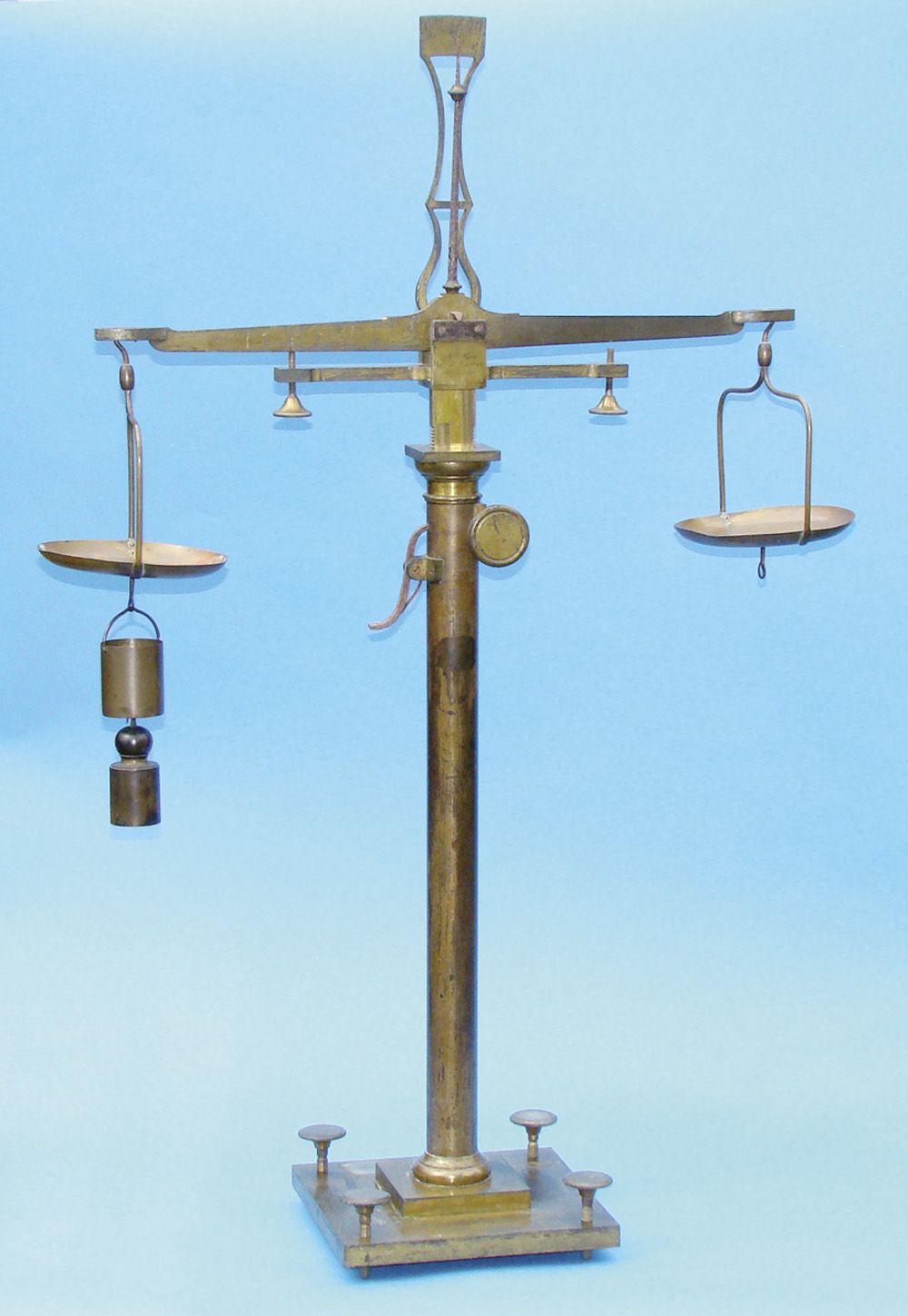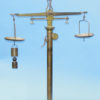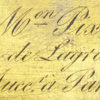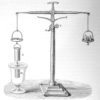LARGE HYDROSTATIC BALANCE
Stock Number: 9358
$2800.
For sale, an antique French hydrostatic balance which demonstrates the principle of Archimedes who realized that if a body is immersed in a liquid, the upper buoyant force, the upward pressure, exerted upon it is equal to the weight of the fluid which the body displaced. This is demonstrated directly by elevating the balance, and, with the little cylindrical bucket empty, placing weights on the right side pan to achieve balance. Then one fills the bucket with water, causing imbalance, and finally lowers the balance enough that the hanging weight (which needs to have the same volume as the bucket), is fully immersed in a vessel of water. Balance is suddenly restored, proving the principle: the upward pressure on the hanging weight is now equal to the weight of the water displaced by its volume, which is exactly that which is now in the little bucket.
Dimensions
34-1/2 inches (88 Focm) tall
Circa
c.1860
Country of manufacture
France
Description
LARGE HYDROSTATIC BALANCE, French, c. 1860, signed “M’on Pixii, Fabre de Lagrange, Succ’r à Paris.” Standing a maximum of 34-1/2″ (88 cm) tall, this impressive brass balance has cylindrical pillar rising above the square base with four leveling screws. Within the pillar a rectangular bar is elevated by rack and pinion, with quick release latch. Atop the bar the 18-1/4″ (46 cm) wide balance beam rests on inset steel pivots, and a crossbar has adjustable stops for damping oscillations of the beam. A long pointer reads against an upper 0±10 scale. There are matching balance pans with hooks underneath, a cylindrical bucket with hanger and hook, and a hanging weight, all of brass. Condition is fine although the original lacquer finish is quite streaked and worn and darkening, and the few iron parts are oxidized.
This is a rather uncommonly found example of the classic hydrostatic balance demonstrating the principle of Archimedes. In the many editions of Adolphe Ganot’s famous text on experimental and applied physics we find a fine illustration of just such a balance, and the explanation of its principle and use. Archimedes realized that if a body is immersed in a liquid, the upper buoyant force, the upward pressure, exerted upon it is equal to the weight of the fluid which the body displaced. This is demonstrated directly by elevating the balance, and, with the little cylindrical bucket empty, placing weights on the right side pan to achieve balance. Then one fills the bucket with water, causing imbalance, and finally lowers the balance enough that the hanging weight (which needs to have the same volume as the bucket), is fully immersed in a vessel of water. Balance is suddenly restored, proving the principle: the upward pressure on the hanging weight is now equal to the weight of the water displaced by its volume, which is exactly that which is now in the little bucket. Similarly, with the hydrostatic balance one can easily determine the volume of a solid object, no matter how irregular its shape, by hanging it from the pan, and weighing both in air and immersed in a liquid. Knowing its volume and its weight gives, furthermore, its specific gravity.
The maker of this good balance was Fabre de Lagrange, successor to the firm of Nicolas Constant Pixii (1776 – 1861, himself nephew and successor to the Dumotiez brothers) and his son Hippolyte Pixii (1808 – 1835), the latter the innovative French maker who developed an early electric generator superior to Faraday’s. Pixii retired in 1855, and the firm passed to “Fabre & Kunemann.” But after several address changes, in 1858 it became just “Fabre de Lagrange,” and continued only until 1862 (see Brenni, 2006). Gaulon (1996) could find no other surviving instrument signed by Fabre de Lagrange alone. It is a very good example of the hydrostatic balance, reminiscent of those by Dumotiez from the late 18th century, but here less decorative, much more spartan and functional.
Ask the Dealer
Dealer information
 TESSERACT
TESSERACT
David and Yola Coffeen both have enjoyed academic careers, as planetary astronomer and as linguist/educator. But since 1982 (yes, 1982!) they have been full-time dealers in early scientific and medical instruments, under the name Tesseract. Selling primarily by catalogue (over 100 issued so far) they also have a web presence at www.etesseract.com, and can be contacted at [email protected].









